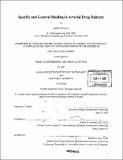| dc.contributor.advisor | Elazer R. Edelman. | en_US |
| dc.contributor.author | Levin, Andrew D. (Andrew David), 1976- | en_US |
| dc.contributor.other | Harvard University--MIT Division of Health Sciences and Technology. | en_US |
| dc.date.accessioned | 2008-02-28T16:12:32Z | |
| dc.date.available | 2008-02-28T16:12:32Z | |
| dc.date.copyright | 2005 | en_US |
| dc.date.issued | 2005 | en_US |
| dc.identifier.uri | http://dspace.mit.edu/handle/1721.1/32857 | en_US |
| dc.identifier.uri | http://hdl.handle.net/1721.1/32857 | |
| dc.description | Thesis (Ph. D.)--Harvard-MIT Division of Health Sciences and Technology, 2005. | en_US |
| dc.description | Includes bibliographical references. | en_US |
| dc.description.abstract | Drug-eluting stents have emerged as the most effective method for treating restenosis following percutaneous coronary interventions. This thesis investigates how drugs with similar physiochemical properties but different specific binding targets yield drastically different tissue transport, retention and ultimately efficacy independent of their putative biological effects. Our central hypothesis is that both specific and general binding of drugs to tissue proteins, as mediated by drug-specific physiochemical properties, plays a central role in arterial transport and distribution. We define and compare the kinetic and transport properties of clinically implemented compounds with different binding modes. While hydrophilic compounds are rapidly cleared, hydrophobic ones are retained with an arterial transmural distribution dependent upon the distribution of specific and general binding sites. Common systemically administered cardiac drugs compete with locally delivered agents through displacement of general binding sites. Exploration of drug binding in thrombus indicates significant specific and general binding capacity. Stent-to- arterial wall drug transfer is acutely sensitive to stent strut position in clot relative to the wall due to thrombus binding capacity. A poorly controlled microthrombotic environment around a stent strut can drastically enhance systemic washout while reducing delivery to the tissue. Together this body of work implies that specific and general binding plays a critical role in the clinical efficacy of locally delivered drugs, and must be a consideration in the rational design of stent-based delivery devices. | en_US |
| dc.description.statementofresponsibility | by Andrew D. Levin. | en_US |
| dc.format.extent | 128 leaves | en_US |
| dc.language.iso | eng | en_US |
| dc.publisher | Massachusetts Institute of Technology | en_US |
| dc.rights | M.I.T. theses are protected by copyright. They may be viewed from this source for any purpose, but reproduction or distribution in any format is prohibited without written permission. See provided URL for inquiries about permission. | en_US |
| dc.rights.uri | http://dspace.mit.edu/handle/1721.1/32857 | en_US |
| dc.rights.uri | http://dspace.mit.edu/handle/1721.1/7582 | |
| dc.subject | Harvard University--MIT Division of Health Sciences and Technology. | en_US |
| dc.title | Specific and general binding in arterial drug delivery | en_US |
| dc.type | Thesis | en_US |
| dc.description.degree | Ph.D. | en_US |
| dc.contributor.department | Harvard University--MIT Division of Health Sciences and Technology | |
| dc.identifier.oclc | 62147535 | en_US |
